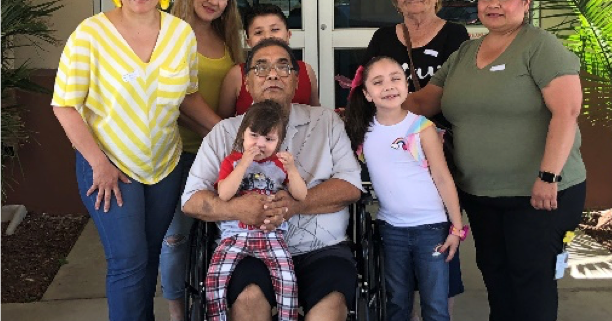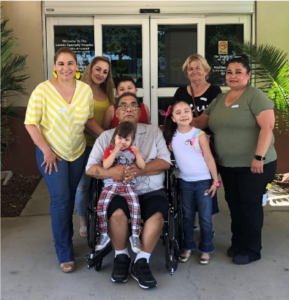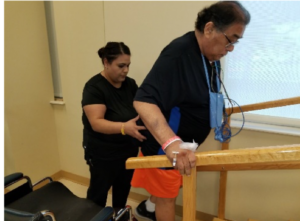This past spring, Juana Rendon went to the ER with complaints of swelling in her legs, hallucinations, labored breathing, altered mental status, and severe hypercapnia. Tests found that Juana had high levels of carbon dioxide and a very low level of oxygen in her blood…
Mr. Cesar Mata is a 69-year-old, retired labor worker and father of six who lives in the Laredo community. Mr. Mata was recently taken to a local acute care facility complaining of shortness of breath and lower leg swelling. Upon arrival at the emergency department, he required emergent intervention. Mr. Mata was also connected to a life support machine that would help him breathe. Physicians diagnosed Mr. Mata with respiratory failure and pneumonia.
From the acute care facility, Mr. Mata admitted to Laredo Specialty Hospital’s respiratory failure program for ventilator weaning. When he arrived, Mr. Mata still could not breathe on his own, speak, eat or walk. He couldn’t do anything for himself and required extensive intervention to achieve basic needs. The road to recovery looked long and difficult. With the continued support of his family, the LSH interdisciplinary team felt confident they could successfully wean him from the ventilator.
Respiratory technicians and the pulmonologist began working with Mr. Mata. While in the hospital, Mr. Mata began an intensive therapy program. The program consisted of physical, speech and occupational therapies. Therapists worked with him daily to build up his strength. Intensive rehabilitation exercises helped Mr. Mata return to his prior level of independence and function. Within two weeks, Mr. Mata could walk with the help of a walker and began eating food by mouth.
LSH staff promoted a healing environment that was able to respond to Mr. Mata’s medical, physical, psychological and social needs. Nurses administered his medications and monitored him around-the-clock to ensure effective disease and pain management. Mr. Mata and his family’s educational needs were of the utmost importance. The nurses made sure to provide disease-specific education. A dietician followed his progress and tailored his diet to his particular nutritional needs. A pharmacist reviewed his medications and provided additional oversight to ensure effective medication management. Case managers worked with Mr. Mata and his family from the time of admission through discharge to facilitate a smooth transition from hospital care to home care.
As a result of Mr. Mata’s dedication and hard work, and with the specialized help of the entire interdisciplinary team at Laredo Specialty Hospital, he made an extraordinary recovery. After 23 days of hospitalization, Mr. Mata could independently and successfully breathe, walk and participate in all activities of daily living.
The staff at LSH are privileged and honored to have shared in his recovery. We are extremely proud of the progress he achieved!
In the battle of the sexes, here’s one that women – often unknowingly – take the lead in: About 55,000 more women than men have strokes every year. Strokes kill more women than men annually, making it the #3 leading cause of death in women.
Most people don’t realize that women suffer strokes more frequently than men. If you’re a woman, you share a lot of the same risk factors for strokes as a man, but a woman’s risk also is influenced by hormones, reproductive health, pregnancy, child-birth and other gender-related factors.
For example, birth control pills may double the risk of stroke, especially in women with high blood pressure or who smoke. And, according to the American Heart Association, hormone replacement therapy – once thought to reduce stroke risk – in fact, actually increases it.
A recent study shared through the National Stroke Association listed these factors that have been found to increase stroke risk in women:
- Menstruation before the age of 10
- Menopause before age 45
- Low levels of the hormone dehydroepiandrosterone (DHEAS)
- Taking oral estrogen or combined oral contraceptives
The study also showed a history of pregnancy complications can also indicate higher stroke risk.
These problems include gestational diabetes and high blood pressure during or immediately after pregnancy.
Add this to other general risk factors for stroke like family history, high blood pressure, diabetes, high cholesterol, smoking, lack of exercise, and being overweight –and it becomes clearer as to why women can be more at risk for stroke than men.
Whatever stage of life a woman is in, it’s important that she be aware of all the risk factors of stroke. As it’s often said, “knowledge is power.” The more knowledgeable a woman is about her stroke risk factors, the more she’ll be able to understand how she can be affected and work with her physician or healthcare provider as appropriate to reduce them.
About Ernest Health
Laredo Specialty Hospital is part of Ernest Health, a network of rehabilitation and long-term acute care hospitals. Ernest Health hospitals see patients who are often recovering from disabilities caused by injuries or illnesses, or from chronic or complex medical conditions.Read More
Quick Reference Links
• Contact Us• Career Opportunities at this Hospital
• Price Transparency
• About Ernest Health






